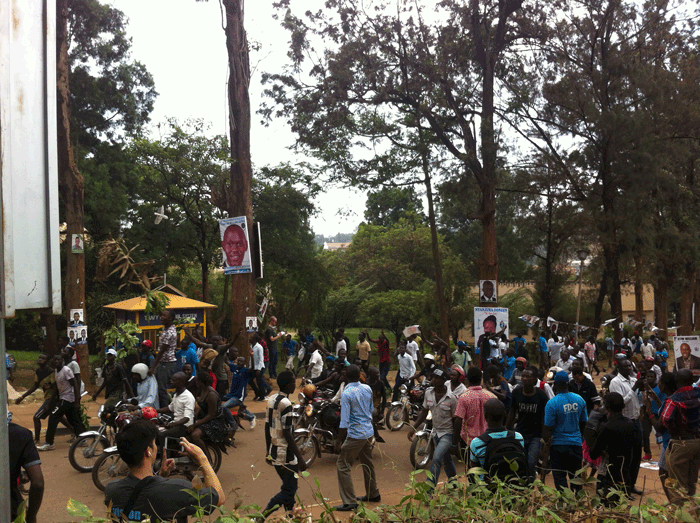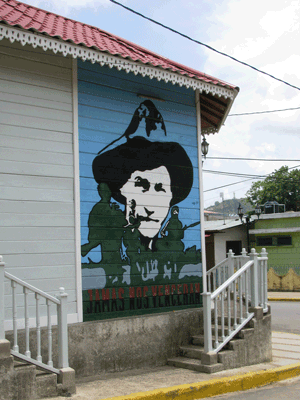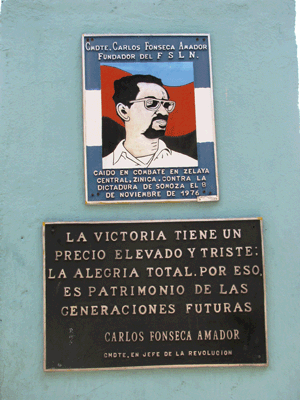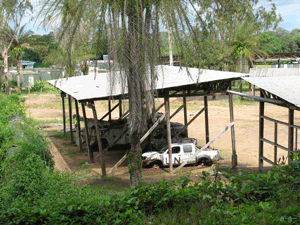By Kai M. Thaler

It is rare in recent years when a civil war has not grabbed global headlines—be it the ongoing civil wars and international interventions in Syria and Yemen, the fragile peace process to end Colombia’s half-century-long war, or the secession and collapse into violence of South Sudan, to name a few. This increase in media coverage reflects a growing number of civil wars around the world: since World War II, civil wars have surpassed interstate wars as the most prominent form of large-scale violent conflict.
Most civil wars end in a government victory or negotiated settlement, but between one-fifth and one-third—depending on the definitions used—end in rebel victory with the capture of the central state or secession.1 Significant scholarly attention has focused on when, why, or how a rebel group takes power; we have little comparative evidence about the downstream effects of rebel victory. What state structures do victorious rebels abolish, modify, or create? How do they decide on policy priorities? What explains variation in the strength and scope of the states they build?
These are important questions to investigate, not only to explain historical variation but to understand the implications for contemporary policy decisions. Global norms of sovereignty privilege sitting governments, but individual states and international organizations or alliances frequently bolster rebel groups or intervene on their behalf. Understanding how a rebel group might act in power is key to evaluating whether they warrant support, or require action to seek their defeat or force negotiations. In the postwar period, knowing the types of state institutions former rebel regimes are likely to construct can help donors protect aid from abuse and ensure that populations are receiving social services and political and economic opportunities. In contemporary Syria, for instance, Western actors would prefer the removal of Bashar al-Assad and his government from power, but also do not want the so-called Islamic State to take over. Out of many rebel groups in the conflict, how would we distinguish which would be most likely to build a strong, stable state that delivers public goods and social services to the population?
 We can and should distinguish between rebel organizations on the basis of their leaders’ goals and political programs; these can be determined during the period of fighting as rebels, rather than only revealed once rebels are victorious and take power. Within the development of any rebel organization, there are multiple potential leaders or leadership groups who may have differing visions for what they want the group to achieve. Regardless of the process, the resulting leader or leaders who win out have the opportunity to orient the organization toward their preferred goals. Focusing on these goals, I distinguish between two types of rebel groups: programmatic and opportunistic.
We can and should distinguish between rebel organizations on the basis of their leaders’ goals and political programs; these can be determined during the period of fighting as rebels, rather than only revealed once rebels are victorious and take power. Within the development of any rebel organization, there are multiple potential leaders or leadership groups who may have differing visions for what they want the group to achieve. Regardless of the process, the resulting leader or leaders who win out have the opportunity to orient the organization toward their preferred goals. Focusing on these goals, I distinguish between two types of rebel groups: programmatic and opportunistic.
Programmatic organizations aim to achieve long-term goals beyond taking power to include transforming socioeconomic and political relations. Programmatic groups aim to provide public goods and services to the majority of the population, rather than seeking only private goods for group members or limited constituencies, as opportunistic groups do. Conversely, opportunistic organizations are characterized by individualism and motivated by short-term private gains of power and material benefits. These groups view the state as a prize to win—a source of group wealth patronage for favored associates, rather than an entity for the benefit of the broader population.
One of the major questions outlining my research is: What kinds of states will these different types of organizations build?
I hypothesize that programmatic groups will focus on establishing state influence over social and economic issues and politicizing society, building mechanisms for political education and institutions to geographically extend state influence and enact their leaders’ ideological visions, as well as incorporating more citizens into the security apparatus. A more programmatic organization should expand the spatial footprint of the state through the increased presence of government functionaries and security forces across the territory, placing state personnel and delivering public goods in areas where they were previously lacking, attempting to connect the core and the periphery of the territory. To incorporate more of the population politically and to be able implement its ideological vision across society, the organization will increase the scope of activities the state undertakes, seeking to affect a wide array of political, social, and economic activities. Economic resources should be channeled to the delivery of public goods and services, rather than into the pockets of leaders, military officers, and bureaucrats.
Opportunistic groups, on the other hand, are expected to engage in minimal state building, and will largely maintain or ignore preexisting state structures, devoting resources primarily to two sectors: security and the economy. They will be concerned about the possibility of coups or rebellions and will invest in the creation of a robust internal security apparatus highly controlled by group leaders and divided to prevent plots. In the economic sector, ministries may be built or maintained to manage production and extraction of natural and agricultural resources, or parallel structures may be created to channel wealth to group leaders. Little emphasis will be placed on increasing state penetration of society (beyond security) or improving socioeconomic development for the masses. Investment in the provision of public goods and social services, such as education and health, will be limited.
In my dissertation, I test this theory through the comparison of three cases of rebel victory: the Frente Sandinista de Liberación Nacional (FSLN) in Nicaragua (programmatic, took power in 1979), the National Resistance Army/Movement (NRA/M) in Uganda (middle ground between programmatic and opportunistic, took power in 1986), and the National Patriotic Front of Liberia (NPFL) in Liberia (opportunistic, took power in 1997). I gathered data through sixteen months of interviews and archival fieldwork, as well as extensive secondary research.2
Despite regional diversity, the three movements came to power against similar backdrops: corrupt, repressive regimes characterized by limited service delivery to citizens and extreme national poverty. All three organizations developed as vanguard movements with relatively strong internal cohesion but limited ties to the population, before expanding out over time. All three fought protracted civil wars before taking power, inheriting devastated—but hopeful—countries excited for the change their new rebel rulers had promised.
 Where the groups differed, however, was in the character and goals of their leaders. The Frente Sandinista de Liberación Nacional (FSLN) in Nicaragua took a programmatic approach as they fought from 1963–1979 and governed from 1979–1990. They had a collective leadership structure drawing people together under the ideological umbrella of Sandinismo, a fusion of Marxism-Leninism, nationalist anti-imperialism, and principles of Catholic liberation theology. FSLN rhetoric and actions sought to develop close ties to the masses and they explicitly stated aims to incorporate marginalized populations into politics, reduce poverty, expand state influence throughout the national territory, and improve health and education services. While they controlled little territory as rebels, these plans were put into practice when they took power, with greater incorporation of women in politics, literacy and vaccination campaigns, and increased presence of state ministries throughout the country, including in service of land reform. The FSLN built a strong state that greatly expanded service delivery and political participation, but they were ultimately undone by a campaign of interference from the United States, which enacted an economic blockade of Nicaragua and sponsored the ‘Contra’ rebellion that plunged the country back into civil war.
Where the groups differed, however, was in the character and goals of their leaders. The Frente Sandinista de Liberación Nacional (FSLN) in Nicaragua took a programmatic approach as they fought from 1963–1979 and governed from 1979–1990. They had a collective leadership structure drawing people together under the ideological umbrella of Sandinismo, a fusion of Marxism-Leninism, nationalist anti-imperialism, and principles of Catholic liberation theology. FSLN rhetoric and actions sought to develop close ties to the masses and they explicitly stated aims to incorporate marginalized populations into politics, reduce poverty, expand state influence throughout the national territory, and improve health and education services. While they controlled little territory as rebels, these plans were put into practice when they took power, with greater incorporation of women in politics, literacy and vaccination campaigns, and increased presence of state ministries throughout the country, including in service of land reform. The FSLN built a strong state that greatly expanded service delivery and political participation, but they were ultimately undone by a campaign of interference from the United States, which enacted an economic blockade of Nicaragua and sponsored the ‘Contra’ rebellion that plunged the country back into civil war.
The National Resistance Army/Movement (NRA/M) in Uganda, which fought from 1981–1986 and has governed since 1986, took a middle-ground approach. They had collective leadership structures, but the organization was clearly dominated by Yoweri Museveni, its chief ideologue and military tactician. Museveni embraced socialism while studying at the University of Dar es Salaam, a hotbed of 1960s leftist African liberation thought. Whether for pragmatic or personal reasons, though, over the course of the NRA/M struggle, Museveni became “deradicalised by armed struggle…less and less of a socialist,”3 and his initial core of more leftist supporters who had “spoken the language of anti-imperialism and socialism”4 began to either moderate or risk marginalization. The organization did, however, build Resistance Councils, new local-level democratic governing bodies, during the civil war and expanded this program once in power. Reluctant to take sides in the ideological battles of the Cold War simply to receive aid, Museveni’s emphasis shifted to pan-Africanism and market-driven developmentalism with some state intervention, shaping the new NRA/M government’s actions. It focused on security and economic reconstruction through agricultural modernization and industrialization, but did also formulate and implement some plans to improve social services, reduce the role of ethnic division in politics, and incorporate more women into politics. The scope of state intervention in society and provision of goods and services remained relatively narrow, however.
The National Patriotic Front of Liberia (NPFL), which fought from 1989–1996 and governed from 1997–2003, took an opportunistic approach. The NPFL emerged after a failed 1985 coup attempt and featured multiple early political and military leaders. Over time, however, one man, Charles Taylor, consolidated power around himself, pushing away or killing off potential rivals and building a cult of personality. The NPFL adopted some rhetoric from progressive Liberian opposition groups, but it never formulated a clear ideology or political plan beyond toppling the government. Taylor reportedly stated that he was uninterested in ideology, in favor of money and power,5 as his “evident aim was to rule,” and he “fought only for [his] own ambitions to hold power for its own sake.”6 The NPFL controlled the majority of Liberia’s territory for much of the war, but despite setting up an alternative government based in the interior city of Gbarnga, this government’s main purpose was to legitimate Taylor’s personal claims to central power and engage in commercial deals with international firms to exploit Liberia’s resources for private wealth and funding the war.7 This pattern continued once Taylor did seize central power. Peace negotiations resulted in elections being held in 1997 and Taylor and the NPFL’s new political incarnation, the National Patriotic Party, won overwhelmingly. This was due, though, to people expecting Taylor to return to war if he lost and the NPFL already being the most powerful faction in society.8 Taylor did not change his ways once he entered into government, using the state and Liberia’s natural resources to secure wealth and fund fighters loyal to him, while neglecting broader public interests. Taylor’s defenders argue that a new civil war emerged too soon for him to put any of his vaguely expressed development plans into action, yet both the FSLN and NRA/M also faced new civil wars within months of taking power.9
 I argue that programmatic groups are, on average, more likely to build stronger states and act in the public interest when they take power, but I do not necessarily expect their priorities to remain static. In fact, many programmatic groups experience a decline over time in their ideological adherence and a diminishing focus on the public interest—power does corrupt. Programmatic organizations like Frelimo in Mozambique, the Communist Party of China, or the African National Congress in South Africa have gradually strayed from their initial programs and seen increasing focus on material benefits for leaders and those they favor.
I argue that programmatic groups are, on average, more likely to build stronger states and act in the public interest when they take power, but I do not necessarily expect their priorities to remain static. In fact, many programmatic groups experience a decline over time in their ideological adherence and a diminishing focus on the public interest—power does corrupt. Programmatic organizations like Frelimo in Mozambique, the Communist Party of China, or the African National Congress in South Africa have gradually strayed from their initial programs and seen increasing focus on material benefits for leaders and those they favor.
What sees less decline, however, is the strength and reach of the state. Organizations are determined to hold onto power, maintaining or expanding the security and surveillance apparatuses and seeking to exert influence over restive areas or social groups. Victorious programmatic rebels have created what today are some of the longest-lasting authoritarian regimes, in countries such as Cuba, China, Vietnam, Angola, Iran, and Zimbabwe.10
As these regimes age and initial revolutionary generations die out, they must seek ways to adapt to changing social, political, and economic conditions both domestically and internationally. Some do this by moderating and seeking to accommodate citizens’ concerns through policy reform, and international concerns through relatively free elections. Others take a more openly repressive tack, something that can breed dissent as the regimes increasingly come to mirror the dictatorships they once toppled. Understanding the roots of these victorious rebel organizations and how they have been able to gain—and in some cases maintain—popular support and build strong states remains key to understanding the prospects for democratization or future conflict in the states they govern. It also points to a dilemma for policy makers and advocates: while opportunistic rebels are never a preferred option to have in government, there may be a tradeoff with programmatic rebel organizations. Rebel victory can potentially provide peace11 and public benefits in the short term, but it may come at the cost of longer-term authoritarianism and repression.
Kai Thaler is a Graduate Student Associate of the Center. He is a PhD candidate in the Department of Government and a Democracy Doctoral Fellow at the Ash Center at Harvard Kennedy School. His research examines civil wars, state building, regime change, and political violence, mainly in Africa and Latin America.
Notes
- Monica Duffy Toft. 2009. Securing the Peace: The Durable Settlement of Civil Wars. Princeton: Princeton University Press.
- Fieldwork was supported by grants from the Weatherhead Center, a Sheldon Traveling Fellowship, and the David Rockefeller Center for Latin American Studies at Harvard, as well as the Tobin Project.
- Ali Mazrui, 2000. “Between Domestic Policy and Regional Power: The Role of Ideology in Uganda.” In No-Party Democracy in Uganda: Myths and Realities, eds. Justus Mugaju and J. Oloka‐Onyango. Kampala: Fountain, 128.
- E.A.Brett, 1993. Providing for the Rural Poor: Institutional Decay and Transformation in Uganda. Kampala: Fountain, 1.
- Daniel Hoffman. 2006. “Despot Deposed: Charles Taylor and the Challenge of State Reconstruction in Liberia.” In Legacies of Power: Leadership Change and Former Presidents in African Politics, eds. Roger Southall and Henning Melber. Cape Town: HSRC Press, 311.
- Yekutiel Gershoni. 1997. “War Without End and An End to A War: The Prolonged Wars in Liberia and Sierra Leone.” African Studies Review 40(3), 60–61.
- William Reno 1998. Warlord Politics and African States. Boulder, CO: Lynne Rienner; and Felix Gerdes, 2013. Civil War and State Formation: The Political Economy of War and Peace in Liberia. Frankfurt: Campus Verlag.
- Multiple interviews, Monrovia, October–December 2015; David Harris, 1999, “From ‘warlord’ to ‘democratic’ president: how Charles Taylor won the 1997 Liberian elections,” Journal of Modern African Studies 37(3): 431–455.
- Multiple interviews, Monrovia, October–December 2015.
- On the durability of programmatic rebels’ regimes, see Steven Levitsky and Lucan Way. 2013. “The Durability of Revolutionary Regimes.” Journal of Democracy 24(3): 5–17; Levitsky and Way 2012. “Beyond Patronage: Violent Struggle, Ruling Party Cohesion, and Authoritarian Durability.” Perspectives on Politics 10(4): 869–89; and Terrence Lyons, 2016. “The Importance of Winning: Victorious Insurgent Groups and Authoritarian Politics.” Comparative Politics 48(2): 167–184.
- See also Toft, 2010. “Ending Civil Wars: A Case for Rebel Victory?” International Security 34(4): 7–36.
Photo Captions
- An opposition rally against the NRM government of Yoweri Museveni, February 2016. Makerere University, Kampala, Uganda. Credit: Kai M. Thaler
- An FSLN mural saying "They will never defeat us," with an image of the movement's inspiration, Augusto Cesar Sandino. San Juan del Sur, Nicaragua. Credit: Kai M. Thaler
- A plaque of FSLN founder and chief ideologue Carlos Fonseca. Leon, Nicaragua. Credit: Kai M. Thaler
- Broken-down UN peacekeeping vehicles. Virginia, Liberia. Credit: Kai M. Thaler
